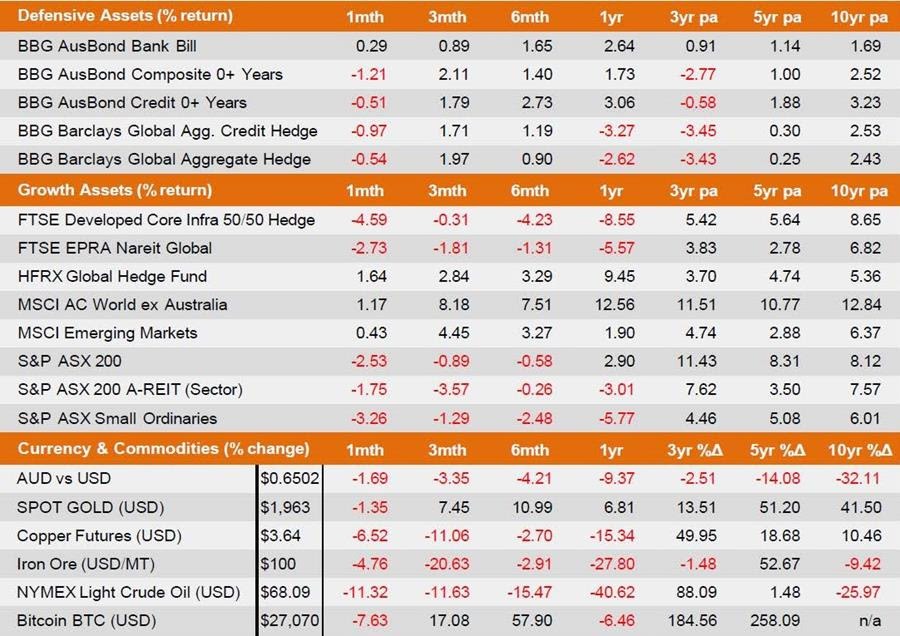While most markets and asset classes struggled in May, mega cap tech stocks exposed to the artificial intelligence (AI) theme continued to drive the majority of US sharemarket performance. The Nasdaq Composite finished the month 5.8% higher, while the S&P 500 added just 0.3% and the Dow jones Industrial Average lost 3.5%. The broader MSCI All Country World ex Australia index was slightly negative in local currency terms, but gained 1.2% from the perspective of domestic investors due to the weaker Australian dollar.
Closer to home, the S&P/ASX 200 lost 2.5% inclusive of dividends, as financials and resources moved lower on heightened economic growth risks. Meanwhile, the Small Ordinaries lost 3.3%, despite the industrial names holding up relatively well. As is the case for many global indices the local tech sector has been the standout performer in 2023, while small cap resources have so far had a year to forget.
Among the more defensive growth assets, infrastructure and property struggled as rising real yields impacted valuations. Elsewhere, cash returns continued to inch higher. However, bond markets sold off throughout May over growing concerns that the US debt ceiling impasse could lead to a catastrophic default. Despite this risk, traditional safe-haven gold lost ground, while Bitcoin experienced a large drawdown and oil prices posted double-digit losses on global growth issues.

Source: Evergreen Consultants, Financial Express, AUD total returns as at 31 July 2022.
There were contrasting moves in US markets during May, as the tech-heavy Nasdaq outperformed the Dow Jones by nearly 10 percentage points, with the latter pulled down by monthly losses of more than 10% from Nike, Walt Disney, Walgreens, 3M, Chevron and Dow Inc. Meanwhile, the benchmark S&P 500 ended the month modestly positive, as volatility remained unusually low.
Of note, Nvidia (NVDA) excited the market when it easily beat earnings estimates and increased guidance driven by AI sales. NVDA shares spiked 24% the day after its earnings and guidance release and briefly joined the trillion-dollar club, before closing the month below it. For many, the AI melt-up came as a welcome distraction from the tense negotiations concerning the US debt ceiling. As the month came to a close, there were signs that a deal had been reached and that the debt ceiling would be suspended prior to the June 5th “X date” (signifying when the US Treasury was projected run out of money). This would allow the US to avoid a disastrous default on its debt.
In commodity markets, oil and industrial metals took another leg down on concerns of weaker global demand, particularly around the trajectory of China’s recovery. The latter was reflected in much weaker performance by China’s sharemarket, which had given back all its gains post the reopening announcement late last year. A similar return pattern was seen among Australia’s resource giants, contributing to the overall weakness of the ASX, outside of the tech sector.
At the beginning of the month, the US Federal Reserve (the Fed) lifted its key interest rate by a quarter-point to the highest level in 16 years (5.25%) but recognised that tighter credit was now having an impact on the economy and that there could be a “mild recession”. Some economists interpreted the commentary as signalling a conditional pause, while markets initially retained positioning for interest rate cuts to begin as soon as September. Elsewhere, weak manufacturing data out of China showed a contraction in activity for a second straight month. In Europe, growth data for Germany confirmed that its economy had gone into a technical recession, while UK inflation remained stubbornly high due to escalating food prices.
On the domestic front, the Reserve Bank of Australia (RBA) defied market expectations and those of most economists when it raised the official cash rate by 25 basis points in early May to 3.85%. The RBA expressed concern that, while inflation had passed its peak, it is still too high. It pointed to tight labour market conditions, with the unemployment rate at a near 50-year low, which has been a key driver of sticky services inflation. The RBA’s hawkish stance seemed vindicated later in the month when the April CPI figures showed inflation had acceleration, driven by rising rents, holiday travel costs and higher fuel prices.
In other news, Australian house prices climbed for a third month in May, led by Sydney rising 1.8%, its biggest increase since September 2021. Housing rental markets saw vacancy rates continue to move lower, with rents soaring. Meanwhile, data from the corporate regulator, ASIC, showed the number of construction industry insolvencies in 2023 alone had risen to the highest yearly total in ASIC’s records going back to 2014. In a worrying sign, personal insolvencies also moved higher.
Disclaimer: This economic and market update has been prepared by Evergreen Fund Managers Pty Ltd, trading as Evergreen Consultants, AFSL 486 275, ABN 75 602 703 202 and contains general advice only.
It is intended for Advisers use only and is not to be distributed to retail clients without the consent of Evergreen Consultants. Information contained within this update has been prepared as general advice only as it does not take into account any person’s investment objectives, financial situation or particular needs. The update is not intended to represent or be a substitute for specific financial, taxation or investment advice and should not be relied upon as such.
All assumptions and examples are based on current laws (as at June 2023) and the continuance of these laws and Evergreen Consultants’ interpretation of them. Evergreen Consultants does not undertake to notify its recipients of changes in the law or its interpretation. All examples are for illustration purposes only and may not apply to your circumstances.